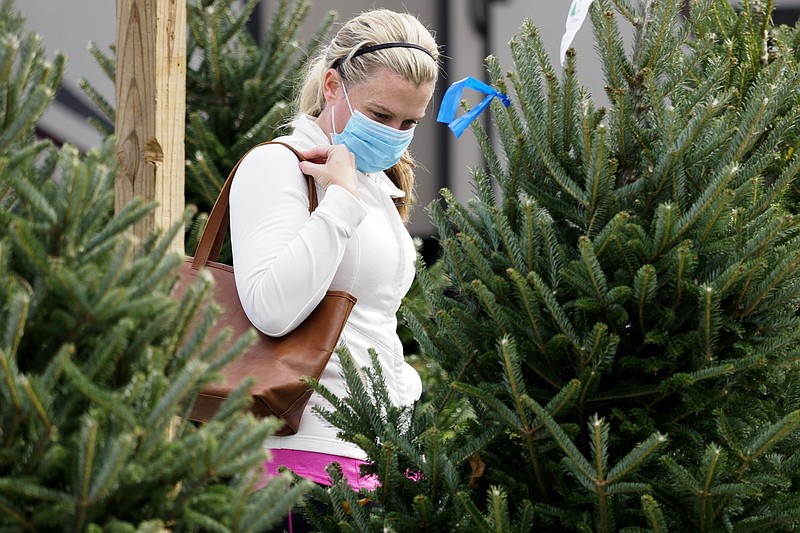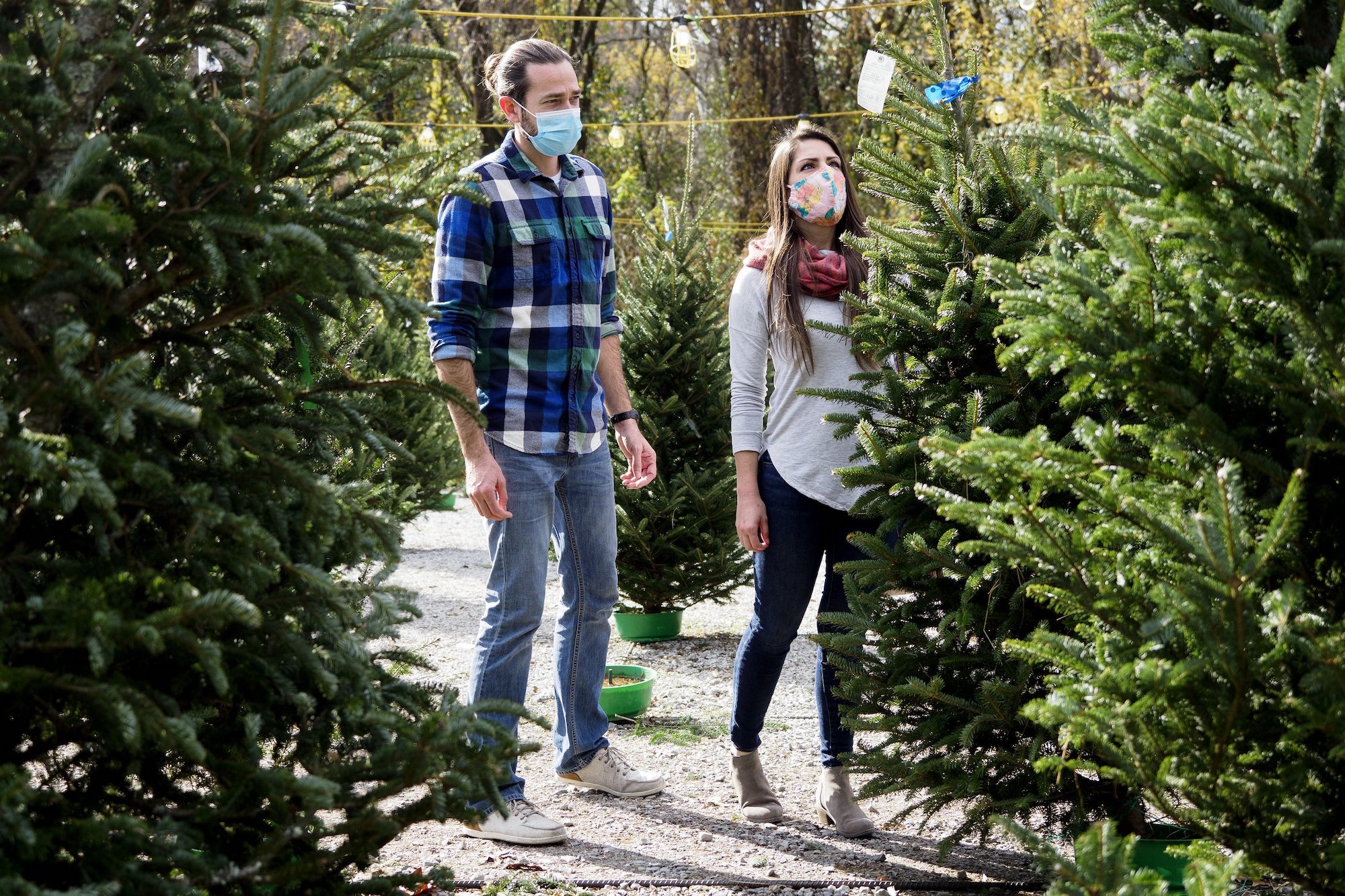Matt Wilcut grew up in a family that regularly decorated with artificial trees, and in his married life with his wife Kristy, Matt was eager to celebrate Christmas with a real tree.
"I love the smell and the look of a real tree," Matt said while shopping this week for a recently cut evergreen at the Weaver Tree Farms retail outlet in Chattanooga.
"I'm nostalgic and real trees just seem more like Christmas," Kristy added.
The Wilcuts are among more than 25 million Americans who will buy a real evergreen tree this year to celebrate Christmas. Although the pandemic is limiting many traditional holiday celebrations and events, Christmas tree growers and merchants are seeing a more jolly season that started early and has continued to accelerate into the early part of December.
"We're seeing a lot of people who are getting their first real Christmas tree this year," said Dan Raulston, owner of the Raulston Acres Christmas Tree Farm just south of Rock Springs, Georgia. "People have been cooped up all year and they want to get outside and make it more of a family event, and buying a real tree is a great holiday tradition."
Raulston, who is also president of the Tennessee Christmas Tree Growers Association, said he is enjoying his best sales year in the 11 years he has been selling trees from his 17-acre farm, and he expects to sell out of trees earlier than normal this year. Already, at least one Christmas tree grower in Middle Tennessee has shut down after selling out of trees in only six days, Raulston said.
A survey of retailers by the consulting firm Evercore ISI reports that Christmas tree sales are up 29% so far in 2020. There's also evidence that people are getting larger trees and buying more home decorations.
"People are staying at home and getting a really big tree," Evercore analyst Ed Hyman said in a research note. "The theory is that people will buy additional wreaths, garlands and a larger tree when times are good, and avoid the extra purchase when times are tough."
Even though the economy has slowed overall, many consumers have extra cash this year because they are staying home more and spending less on travel, vacations, restaurants and entertainment.
"People have the time at home this year and they really want something to spark their mood because of the COVID stress that everybody's under," said Doug Hundley, a spokesperson for the National Christmas Tree Association.
Usually starting in October for artificial trees and the weekend before Thanksgiving for most natural tree merchants, the Christmas tree buying season reaches full force in the days following Thanksgiving, when consumers begin buying trees, wreaths and other decorations to put up in their homes for the holidays.
Americans typically spend about $2 billion a year to buy between 25 million and 30 million real Christmas trees and another 10 million to 20 million artificial ones, according to Statista. Because artificial trees can be reused every year, over 75% of U.S. homes that put up a Christmas tree have an artificial tree - and the market for fake trees has been growing about 4% a year.
The growers of natural pines, firs, spruces and other evergreen trees used as Christmas trees hope to regain some of the market share for real trees this year.
With holiday parades and festivals canceled, home-bound families have time to water a natural tree this year and many are also are looking for ways to make the season special. Marsha Gray, executive director of the Christmas Tree Promotion Board, said fresh-cut Christmas trees are usually displayed outside where there's less risk of viral spread than inside retail stores selling artificial trees.
"Getting a real tree involves the choosing, the hunting for it, the family outing," Gray said. "It really is a memory maker. It's a day you spend together, and it really becomes much bigger than the tree itself."
Reusing an artificial tree may prove to be less expensive over time, but the National Christmas Tree Association promotes the fact that buying a real tree keeps more money at home since nearly all real trees are grown in the United States, while 80% of artificial trees are made in China.
The prices for natural Christmas trees are up slightly from a year ago, but some retailers are holding the line on any increases in prices, especially in the South where abundant rains helped tree growers this year.
"Our prices are pretty stable compared with last year, but we're definitely seeing more buying earlier this year," said John Weaver, owner of Weaver Tree Farms, a wholesale and retail Christmas tree grower in West Jefferson, North Carolina, which has operated a retail lot on Signal Mountain Road in Chattanooga for the past 34 years. "It seems like everybody is decorating their homes this year since they can't really go anywhere. It's going to be a quick season, so if you want to get a tree you better buy now."
The Associated Press contributed to this report
Contact Dave Flessner at dflessner@timesfreepress.com or at 423-757-6340.
Christmas trees by the numbers
* 26.2 million - The estimated number of real Christmas trees purchased in 2019* $76.87 - The median price of real Christmas trees purchased by last year, up from $66.43 in 2018* 32% - The share of real Christmas trees bought at “choose and cut” farms* 350,000 - Number of acres in production for growing Christmas trees in the U.S.* 15,000 - Number of farms in the U.S. growing Christmas trees. The tops states, in order, are Oregon, North Carolina, Michigan, Pennsylvania, Wisconsin and Washington.* 7 years - The average growing time for a real Christmas tree, although it can take as many as 15 years to grow a tree of typical height (6 – 7 feet) or as little as four yearsSource: National Christmas Tree Association (NCTA). The most common Christmas Tree species are balsam fir, Douglas-fir, Fraser fir, noble fir, Scotch pine, Virginia pine and white pine.


